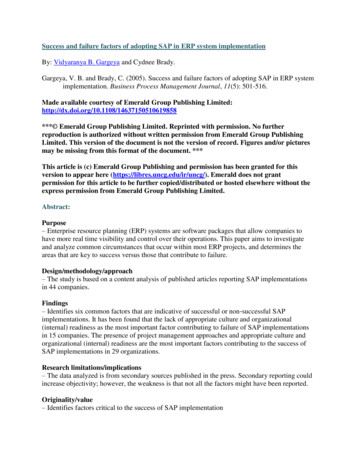
Transcription
Success factors for digitaltransformation in banksResearch shows that the winning formula involves agile, adaptable,and curious finance leaders.
Success factors for digital transformations in banks Banking has gone digitalEngineering re-engineeredDigitalization on a global scale has revolutionizedtraditional banking.Figure 1Whether the goal is to enhance the customerexperience, reduce bottom-line costs, or grow reachand market share, digitization plays an important part inachieving banks’ ambitions. Digitization promises banksgreater productivity, lower transaction costs, greatercapital efficiency and stronger operational resilience.FinTech applies digital technologies to all aspects ofbanking transactions. The opportunity is for banksto become more productive, with lower transactioncosts, greater capital efficiency, and strongeroperational resilience. But the promise requiresbanks to develop new capabilities.To deliver on these promises, banks have invested inFinTech—the industry that applies digital technology toall financial activities, impacting processes, products,and business models of financial services organizations.In fact, FinTech investment has increased from US 2.5billion in 2012 to US 12.7 billion in 2016 (CB-Insights,2017). Of note, US and Japanese banks occupy sevenout of top 10 spots in terms of number of FinTech dealsbetween 2015 and 2016 (CB-Insights, 2017).Organizations that invest in FinTech look to addressa broad range of transactions, such as electronicpayments, online remittances, crowd funding, equityfinancing, and may also leverage the technology tocollect and analyze data for work processes and tooptimize banking infrastructure.Yet, digital advancements make demands of banks andimpact areas far beyond the implementation of the newtechnologies. Digitization requires banks to develop newcapabilities from existing talent; to attract, develop andretain new talent that can keep step with the connectedconsumer; and to ensure leaders are ready to take theirorganizations on a journey of transformation.1The Digital ialResearchPayments ConsumerBanking
Success factors for digital transformations in banks Four success factors for a digitalbanking transformationResearch using data from KF4D shows that whicheverfunctional roles finance leaders are placed in, they tendto demonstrate higher learning agility. This is especiallyso for leaders involved in digitization work in banks—leaders involved in IT, marketing, and strategic planning.Figure 2Learning Agility scores.Data from Korn Ferry’s Four Dimensions of Leadership & Talent (KF4D) study indicatethat finance leaders have higher learning agility compared to other business cesInformationTechnologyAll industry leadersMarketingStrategicPlanningFinance leadersBanks Under Pressure to TransformKorn Ferry Hay Group research highlights megatrends that will accelerate the pace of banking transformation:2nGlobalization 2.0 enables customers to have a broader choice as global banking becomes seamless.nDemographics will also shift toward millennials who seek the best services through digital platforms.nTechnological convergence will meannThe race for innovation and first-mover advantage is now more intense than ever before (Vielmetter & Sell, 2014).greater innovation in banking and all businesses complementary to banking.
Success factors for digital transformations in banks A recent poll with global senior client partners inKorn Ferry Hay Group suggests that for banks to besuccessful in transformation in the digital era, thereare four critical areas on which to focus.Just as important is the broader value that an employerbrand can deliver, such as the increased retention anddeeper engagement of talented people already on theteam.First, high levels of learning agility in the bankingworkforce is required to capture opportunities in themarket. From more than 200 senior executive interviews,Korn Ferry research showed clear links between learningagility and the success of individual executives to adaptand lead. Therefore, learning agility is crucial to executiveswho are leading areas that are undergoing change anddisruption, such as a digital transformation. Interestingly,finance leaders demonstrate higher levels of learningagility (see Figure 1.)With the ongoing war for digital talent, strongemployer branding will become the competitiveadvantage. In fact, research indicates that employerbranding is one of the top five priorities among theboards of directors in almost half of the organizationssurveyed.The importance of learning agility also extends to thebroader workforce, especially the key traits of mentalagility and change agility. Korn Ferry research has shownthat companies with a highly agile workforce have 25percent higher profit margins than their peers.Second, developing an enterprise culture of high-riskappetite for digital strategies will bring about greaterbusiness success in digitization. The global financialmeltdown led to a crisis of confidence among businessleaders and consumers, and as a result, banks becamemore risk averse. Korn Ferry research, however, pointsto an emerging need for a fresh and disciplined approachto risk-taking to seize the opportunities of FinTech anddrive an organizational digital transformation.Fourth, high levels of digital leadership among seniorleaders is a necessity for successful digitization.Companies must have the right mix of digitally readyand digitally expert talent to lead and execute asuccessful transformation. This is especially true fortraditional companies looking to embrace a digitalfuture.Developing digital leadership from within or acquiringdigital leadership from the outside comes withchallenges. It requires deep knowledge and expertiseto identify the needed leadership traits, maintain thebalance of leadership strengths, and enable leaders tolead. Nonetheless, the work is worth it: Research hasshown that leaders in firms with high digital leadershipnot only have strong ability to engage customersdigitally but also to increase top-line growth.Figure 3Risk-taking runs counter to the traditional values ofbanks, where mitigating risk and ensuring predictabilityand stability are prized. This will require a change ofculture, but the effort will position banks to tap intonew opportunities for growth.Third, developing a strong employer branding is amust. Korn Ferry research shows that a strong employerbrand helps organizations attract talent directly, whichsignificantly reduces reliance on agencies and externalspecialists. The benefits are not simply related to cost.Success factors for a digital bankingtransformation.Highly gEmployerBranding3StrongRisk CultureforDigitization
Success factors for digital transformations in banks Transformation begins with leaders.While building an agile workforce, developing a riskculture for digitization, and improving employerbranding are important levers, leadership in banksis the key to unlocking digital transformation success.Leaders set the environment for change and are theagents of change. According to Vielmetter and Sell(2014), leaders need to be flexible, internationally mobile,culturally adaptable and sensitive, highly collaborative,and strong conceptual and contextual thinkers.Figure 4Organizational climate of financial institutions.Impact of Leadership Style on OrganizationalClimate. 59% of the organizational climate offinancial institutions is demotivating, likelyresulting in poor performance.16%High performingOf concern, then, are Korn Ferry Hay Group findings basedon research of over 5,000 financial services leaders, whichshow that certain types of leaders could derail a digitalbanking transformation. The gaps are summed up inleadership styles, engagement, and emotional ingLeadership stylesResearch indicates that financial services leaders tend toexert a coercive/directive leadership style more often thanleaders of other industries. A coercive/directive leadershipstyle demands compliance with orders. It is associatedwith efforts to motivate that focus on the consequencesof noncompliance, e.g, “Do it, or else.” This style can beuseful during short periods of crisis but, if used longerterm, has a negative impact on the work environment andwill produce poor performance (see Figure 4).A deeper dive into the data reveals that 40 percent ofbanking leaders rely on one dominant leadership style, and64 percent of financial services executives rely on at mosttwo leadership styles. This narrow use of leadership stylesconstrains leaders from flexing and adapting—traits thatare required to remain agile through a transformation, toengage and motivate others successfully, and to respondto the dynamic financial marketplace.4Employee and customer engagementIt should come as no surprise, therefore, thatfinancial services leaders perform poorly when itcomes to employee engagement. In a comparisonbetween financial institutions and high-performingorganizations from other sectors, findings show thatthe financial organizations lag. Banks should considerthe dimensions focused on motivating employees andexploring employees’ intention to stay (see Figure 5).
Success factors for digital transformations in banks Figure 5Limited organizational engagement in financial institutions.1The data also points to an inward orientation in financialservices organizations, with low scores for customer focusand client-related innovation.Emotional intelligenceA Korn Ferry study comparing the emotional intelligenceprofiles of financial services leaders with leaders from othersectors found that, overall, financial services leaders scoredlower. Emotional intelligence encompasses understanding,empathy, and the ability to influence.Executives with highempathy are better atkeeping employeesengaged, and employeeswith empathy givecustomers the very bestexperience.This should raise a flag for banks because research suggeststhat emotional intelligence is twice as important as cognitiveability in predicting outstanding performance.This troubling emotional intelligence finding is furthercompounded by the fact that financial services leadershave psychological blindness around their leadership gaps.Korn Ferry Hay Group data indicates that financial servicesleaders tend to see themselves in a more positive lightcompared to how others see them. Further, this self-andothers ratings gap is significantly bigger amongst financialservices leaders than leaders in other industries (see Figure 6).15Based on in-depth analysis of Korn Ferry Hay Group’s Insight database, 2007-2011.Study of 63 financial institutions vs. 71 high performing organizations from other sectors.Daniel GolemanContributor, Korn Ferry Institute
Success factors for digital transformations in banks Figure 6Gaps between self and others’ perceptions: financial services leadersvs. other lf-awarenessInspiringLeaderAdaptabilityOther industriesFinancial services executives rate themselves highly forgoal orientation, resilience, and analytical thinking, andindicate preferences for well-structured, conventionalenvironments. Yet, the data also shows these executivesfind collaboration challenging, tend to be poor listeners,are unwilling to compromise, and lose the broader picturewhile focusing on details. Blind spots like these canseverely hamper an executive’s ability to embrace orlead a transformation.With a predominant coercive/directive leadership style,an inward-facing orientation, and opportunities forimprovement in emotional intelligence and self-perception,leaders of banks need help to lead a digital transformation.26Based on in-depth analysis of Korn Ferry Hay Group’s Emotional and Social Competency Inventory (EXCI)database, 2011-2013. This analysis comprised 1,021 financial services leaders and over 12,000 industry leaders.
Success factors for digital transformations in banks Onepath to re-engineeredsuccess: a case study.EngineeringA top global bank was looking to revolutionizecustomers’ experience at branch level.The bank engaged Korn Ferry Hay Group as apartner to bring along the leadership team on thisjourney. It began with ensuring there was clarity aroundwhat contributed to positive customer experience,alignment amongst leaders and then defining aculture that would bring about the transformation.It is worth noting that the critical element of thisjourney—the enablers—concentrated on the bankleaders themselves. Korn Ferry Hay Group workedclosely to identify, quantify, and develop the rightleadership behaviors to make the journey possible.Leveraging research data and instruments, Korn FerryHay Group focused on enhancing learning agility andthe key traits that enabled the leaders to embracedigitization so that they could perform and drive success.That success encompassed many areas, includinga reimagined “physical digital” space that featuredultra-modern account-management kiosks, wall-sizedinteractive displays, and new platforms for bankers andcustomers to engage in customized solutions.After debuting the digital service in Tokyo, the globalbank moved from the 57th position to first in an annualsurvey of retail banks. This impact was subsequentlytranslated to greater market share for the firm.Going digitalDigitization has revolutionized traditional banking,bringing with it opportunities to enhance the customerexperience, reduce bottom-line costs, and grow reachand market share.Banks that want to take advantage of theseopportunities are looking to digitization and are makinginvestments in FinTech. But the shift requires morethan investments in technology. Banks must focus onfour additiona
Success factors for a digital banking transformation. Success Factors Strong Employer Branding Highly Agile Workforce Strong Risk Culture for Digitization Digital Leadership. 4 While building an agile workforce, developing a risk culture for digitization, and improving employer branding are important levers, leadership in banks is the key to unlocking digital transformation success. Leaders .











